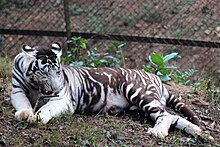White tiger
White male tigers reach weights of 200 to 230 kilograms (440 to 510 lb) and can grow up to 3 meters (9.8 ft) in length.
Their rarity could be because the recessive allele is the result of a one-time mutation, or because white tigers lack adequate camouflage, reducing their ability to stalk prey or avoid other predators.
A knockout mutation in this gene results in albinism, the ability to make neither pheomelanin (red and yellow pigments) nor eumelanin (black and brown pigments), while a less severe mutation in the same gene in other mammals results in selective loss of pheomelanin, the so-called Chinchilla trait.
[10] Instead, in white tigers, a naturally-occurring point mutation in the SLC45A2 transport protein gene was found to underlie its pigmentation.
The resultant single amino acid substitution introduces an alanine residue that protrudes into the transport protein's central passageway, apparently blocking it, and by a mechanism yet to be determined, this prevents pheomelanin expression in the fur.
[6] Mutations in the same gene are known to result in 'cream' coloration in horses,[6] and play a role in the paler skin of humans of European descent.
[12][10] Inbreeding promotes recessive traits and has been used as a strategy to produce white tigers in captivity, but this has also resulted in a range of other genetic defects.
White tigers, Siamese cats, and Himalayan rabbits have enzymes in their fur which react to temperature, causing them to grow darker in the cold.
[13] Kailash Sankhala observed that white tigers were always whiter in Rewa State, even when they were born in New Delhi and returned there.
An additional genetic condition can result in near-complete absence of stripes, making the tiger almost pure white.
One such specimen was exhibited at Exeter Change in England in 1820, and described by Georges Cuvier as "A white variety of Tiger is sometimes seen, with the stripes very opaque, and not to be observed except in certain angles of light.
"[15] Naturalist Richard Lydekker said that, "a white tiger, in which the fur was of a creamy tint, with the usual stripes faintly visible in certain parts, was exhibited at the old menagerie at Exeter Change about the year 1820.
The modern strain of snow white tigers came from repeated brother–sister matings of Bhim and Sumita at Cincinnati Zoo.
As a result, stripeless white tigers have appeared in zoos as far afield as the Czech Republic (Liberec), Spain and Mexico.
Siamese cats and albinos of every species which have been studied all exhibit the same visual pathway abnormality found in white tigers.
Because of the visual pathway abnormality, by which some optic nerves are routed to the wrong side of the brain, white tigers have a problem with spatial orientation, and bump into things until they learn to compensate.
[14] A condition known as "star-gazing" (the head and neck are raised almost straight up, as if the affected animal is gazing at the stars), which is associated with inbreeding in big cats, has also been reported in white tigers.
[28] This is due to their inability to produce normal tyrosinase, a trait they share with albinos, according to zoo veterinarian David Taylor.
He treated a pair of white tigers from the Cincinnati Zoo at Fritz Wurm's safari park in Stukenbrock, Germany, for salmonella poisoning, which reacted strangely to the anaesthesia.
[30][31] This condition is similar to albino mutations and causes bluish lightening of the fur color, crossed eyes, and prolonged bleeding after surgery.
There has been a single case of a white tiger having central retinal degeneration, reported from the Milwaukee County Zoo, which could be related to reduced pigmentation in the eye.
Premature deaths in other collections may be artifacts of captive environmental conditions...in 52 births we had four stillbirths, one of which was an unexplained loss.
[35] The Lowry Park Zoo in Tampa Bay had four of these white Amur tigers, descended from Robert Baudy's stock.
The Indian government reportedly considered the offer;[38] however, India had a moratorium on breeding white tigers after cubs were born at New Delhi Zoo with arched backs and clubbed feet, necessitating euthanasia.







